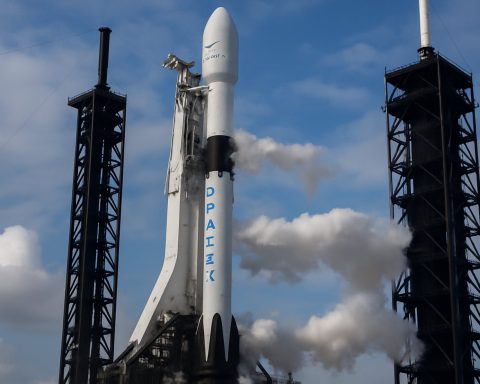- The Space Force’s NSSL-3 program plans 84 space launches from 2027-2032, allocating $13.7 billion, driving significant industry changes.
- SpaceX secures $5.9 billion and leads the space race, leveraging its versatile fleet and successful track record.
- Blue Origin makes a breakthrough with $2.4 billion in contracts, marking its ascent as a formidable player.
- United Launch Alliance faces challenges due to Vulcan rocket delays, losing its dominant position but sees potential for growth with recent certification.
- Rocket Lab and Stoke Space join as strong competitors, capturing $5.6 billion for experimental missions, emphasizing the industry’s dynamic nature.
- The space industry emphasizes innovation and agility, with entities adapting quickly set to succeed in a rapidly changing environment.
The cosmos is about to transform into a bustling canvas of ambition and innovation. From 2027 to 2032, the Space Force’s third phase of the National Security Space Launch program (NSSL-3) heralds an ambitious era with a staggering plan for 84 launches and a colossal $13.7 billion up for grabs. This unprecedented expansion marks a seismic shift in the space industry, highlighting a narrative of winners and losers defined by innovation, agility, and strategic foresight.
SpaceX Sprints Ahead
SpaceX emerges as the titan of this celestial drama, capturing the lion’s share of contracts and symbolic sway. With $5.9 billion secured, Elon Musk’s brainchild continues to soar, outpacing traditional heavyweights United Launch Alliance (ULA), the joint endeavor of Boeing and Lockheed Martin. The secret of SpaceX’s runaway success lies in its proven track record and versatile fleet, which now envelops a myriad of tasks from launch services to mission studies and rapid anomaly resolutions.
Blue Origin’s Big Break
Despite SpaceX’s dominance, Jeff Bezos’ Blue Origin savors a significant milestone. Garnering $2.4 billion, Blue Origin ventures into the big league, stepping out of the shadows to challenge the established order. The leap from zero to 18% in NSSL-3 funds illustrates the quiet power of perseverance and innovation.
The ULA Conundrum
Meanwhile, ULA finds itself at a crossroads. Tasked with executing fewer missions than initially anticipated, it relinquishes its past 60% hold on contracts, now sharing a slimmer slice of the pie at less than 40%. Delays in the Vulcan rocket’s facilities and certification have rerouted payloads to SpaceX, sparking concerns over ULA’s ability to regain footing.
However, the road ahead is not without hope. Having recently achieved Vulcan certification, there lies potential for strategic growth. Investors keen on Boeing and Lockheed’s destiny must now navigate these churning waters with insight and caution.
The Emergence of New Challengers
Amid this reshuffling, Rocket Lab and Stoke Space enter as promising contenders, capturing $5.6 billion in NSSL-3’s experimental endeavors with uncertified rockets. Their participation underscores a vibrant competitive landscape, embracing nascent ideas and fueling a new wave of space exploration.
The poignant lesson in this cosmic orchestrating is clear: agility and innovation are paramount in this rapidly evolving arena. As the countdown to 2027 begins, entities poised to adapt swiftly stand to gain the most in this ever-crowded universe. In the realm of the stars, change is inevitable—and only those ready to embrace it will thrive.
The Future of Space Launch: What to Expect from 2027 to 2032
Market Forecast & Industry Trends
From 2027 to 2032, the space industry is set for transformative growth driven by the National Security Space Launch program (NSSL-3). This ambitious initiative, with 84 planned launches and $13.7 billion in contracts, symbolizes a pivotal era in space exploration and security. Here are additional insights and trends that may shape this dynamic period:
1. Increased Role of Private Sector: The heavy involvement of companies like SpaceX, Blue Origin, and others highlights a shift towards privatization and commercial leadership in space exploration. This trend is expected to continue as technological advancements make space more accessible to non-government entities.
2. Innovation through Competition: The significant participation of new players like Rocket Lab and Stoke Space emphasizes how competition can drive innovation. By focusing on experimental technologies and uncertified rockets, these companies are pushing the boundaries of what’s possible in space launch.
3. Growing Demand for Satellite Deployment: As global internet connectivity and Earth observation demands increase, the need for frequent, reliable satellite launches is expected to rise significantly. This will drive further investment in launch capabilities and infrastructure.
4. Sustainability Concerns: With the increase in launches, the industry will need to address sustainability, such as minimizing space debris and developing more eco-friendly rockets. Companies that pioneer sustainable practices may have a competitive advantage.
Pressing Questions and Insights
How Will SpaceX Maintain Its Competitive Edge?
SpaceX has secured $5.9 billion in contracts, largely due to its diversified fleet and successful track record. The company’s focus on reusable rockets, notably the Falcon 9 and Starship, allows it to offer cost-effective solutions. Continuous innovation and maintaining reliability will be key for keeping their lead.
What Does Blue Origin’s Success Mean for the Industry?
Blue Origin’s $2.4 billion contract marks its serious entry into the space launch arena. The company’s emphasis on reusable launch vehicles, like the New Glenn rocket, highlights its commitment to reducing costs and capturing significant market share.
Will ULA Reclaim Its Former Dominance?
The United Launch Alliance (ULA) faces challenges with a reduced contract share. However, with the recent Vulcan rocket certification, ULA has the potential to bounce back if it can leverage this new capability alongside its proven reliability. Strategic partnerships and competitive pricing could be pivotal.
How to Navigate Investments in the Space Sector?
Investors should focus on companies with proven technologies and those investing in next-gen launch systems. Monitoring industry announcements and technological breakthroughs will be vital in making informed investment decisions.
Real-World Use Cases
– Military Applications: Secure and reliable access to space will enhance national defense capabilities and satellite-based communication systems.
– Scientific Research: More frequent launches will facilitate scientific missions, allowing for advancements in space science and exploration.
– Commercial Ventures: As the cost of reaching space decreases, new commercial possibilities, such as space tourism and resource mining, become viable.
Actionable Recommendations
1. Stay Informed on Technological Developments: Regularly check for updates on rocket technologies, especially in materials and propulsion, which can impact launch costs and capabilities.
2. Consider Environmental Impact: Support companies prioritizing sustainable practices to minimize long-term ecological effects on space and Earth.
3. Invest in Education and Skill Development: The evolving space industry will require a skilled workforce adept in advanced engineering and technology.
For more insights and developments in the space industry, visit the SpaceX website and Blue Origin.
By embracing these trends and insights, stakeholders in the space industry can better navigate the challenges and opportunities that lie ahead. As we gear up for this exciting new frontier, readiness to innovate and adapt will determine success.









